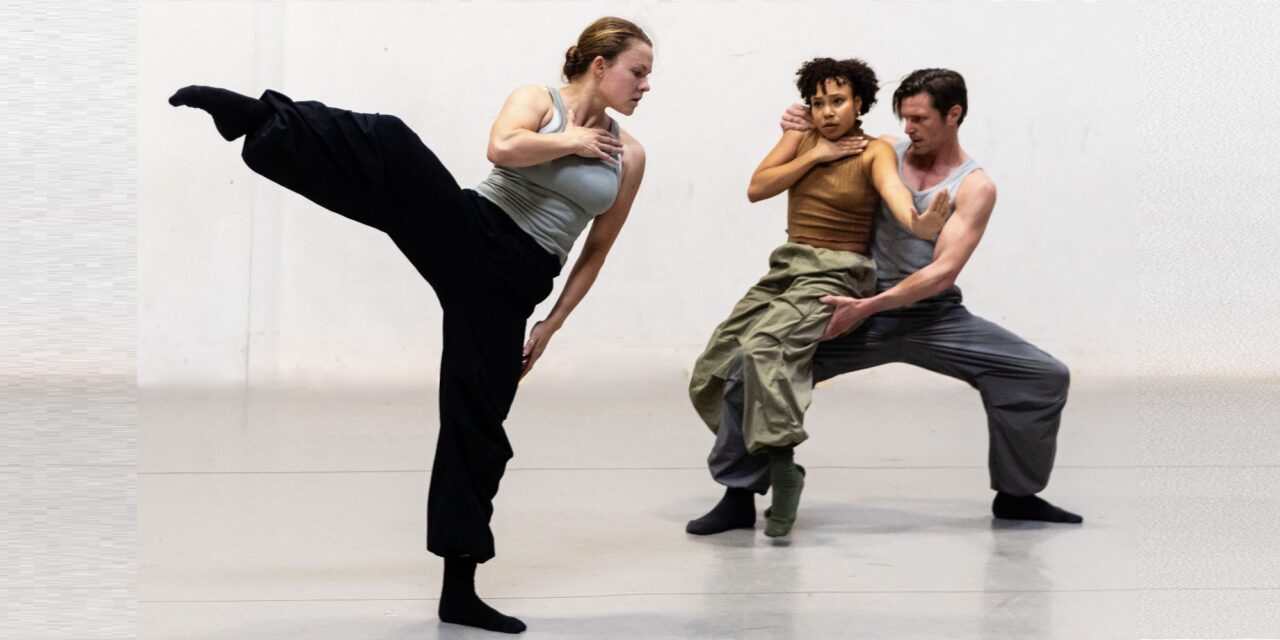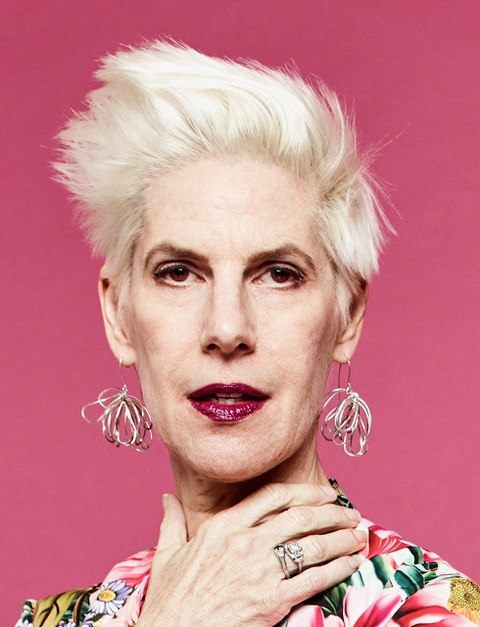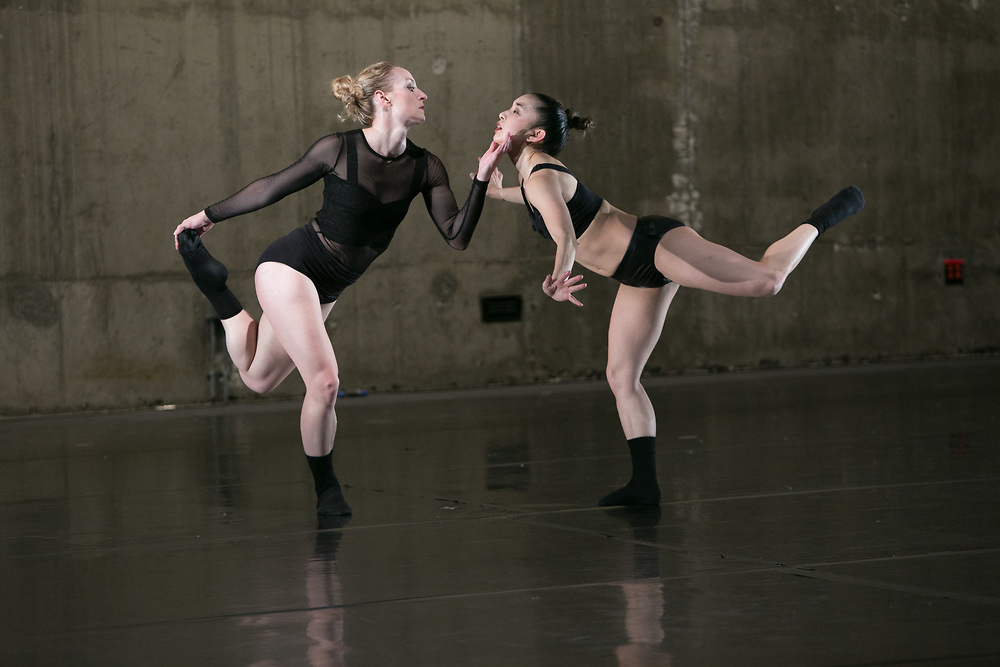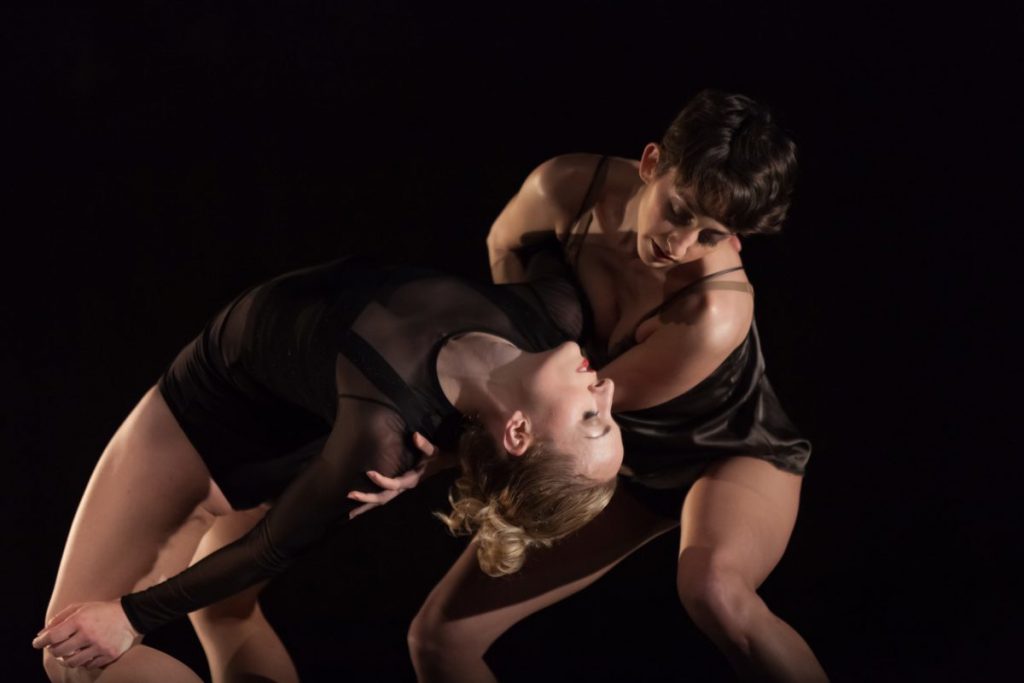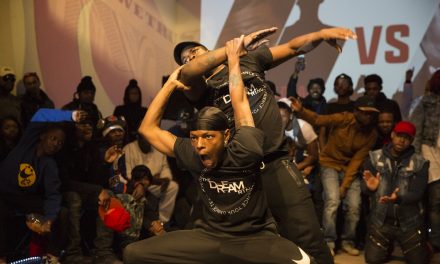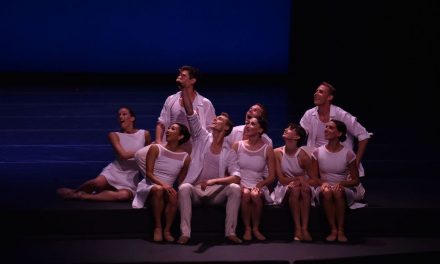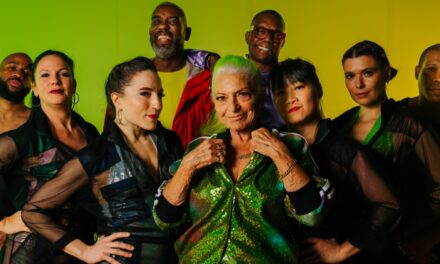As a choreographer, Laurie Sefton is a thoughtful provocateur. Hot button social, cultural and political issues she has targeted include bullying, the distorting effects of social media, gender identity, and a former president’s recognizable repertoire of hand gestures.
Laurie Sefton Creates returns with its newest Herd. Person? which she describes as “inspired by the events of January 6 and the reality of late stage democracy in America.” The work premieres at LA Dance Project on February 22, 23 and 24 along with two other Sefton works, Triptych: Experience in Defiance her 2018 collaboration with LA-based hip hop and spoken word artist Jason Chu and an excerpt from Girl, Get Off, her 2017 plea for sexual tolerance. The dancers performing with Laurie Sefton Creates are: Gretchen Ackerman, Marlie Couto, Marirosa Crawford, Isaac Huerta, Maddie Lacambra, Myko Lyric, Sidney Scully, and Nicholas Sipes.
Two LADC staff watched separate rehearsals of Herd. Person? and afterwards spoke with Sefton about the new work, the choice of the other two works, the dancers, and her post-pandemic name change from Clairobscur to Laurie Sefton Creates. Since similar topics were discussed in both conversations, the interviews have been consolidated.
LADC: One of the changes emerging from the pandemic was your name change from Clairobscur to Laurie Sefton Creates. Why the change?
Sefton: In 2018, we received a grant from the California Arts Council to do a brand audit. We hired a marketing company and they did a thorough audit. The big thing that came back was that my name was not associated in any way with the company. That was their conclusion.
We already had been talking off and on about rebranding the company and then during Covid, I dyed my hair blonde and cut off all my hair. During Covid we all felt the need for change.
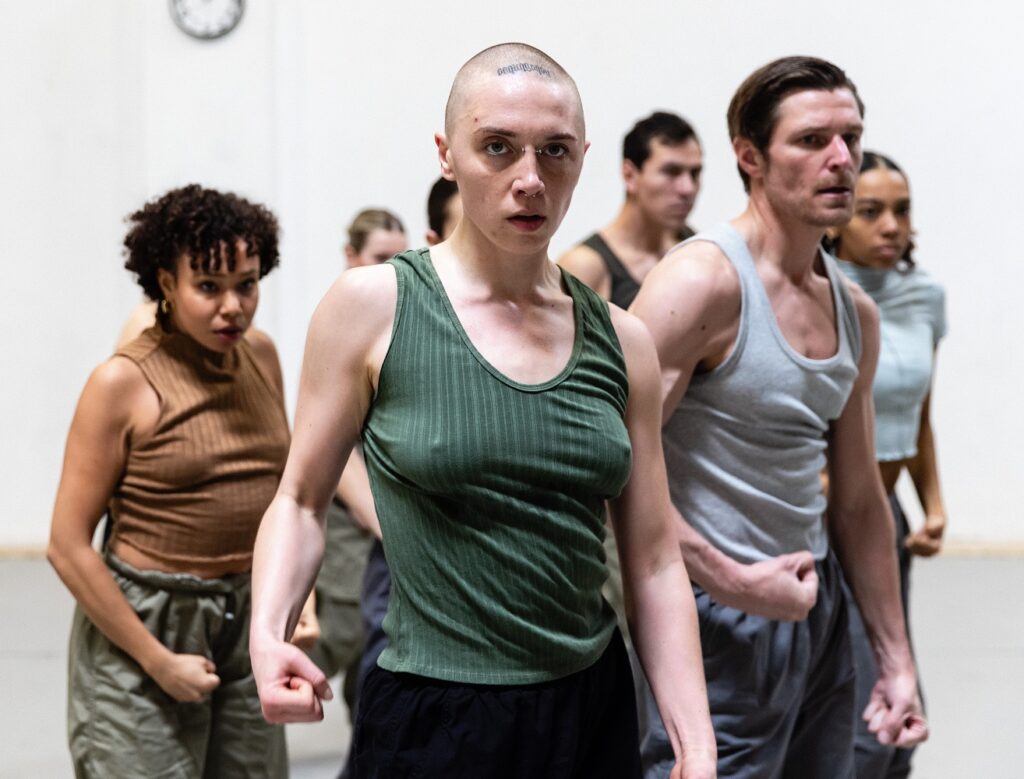
Laurie Sefton Creates – Herd Person, rehearsal, Choreographer Laurie Sefton, dancers Myko Lyric, Gretchen Ackerman, Isaac Huerta, Nicholas Sipes, Marirosa Crawford – Photo by Skye Schmid Varga.
LADC: So you don’t use Clairobscur at all?
Sefton: It’s still our legal entity, we still have the original website, and it still means something to all my work. Clairobscur is the French translation of chiaroscuro, a 17th century painterly term which means an effect of contrasted light and shadow created by light falling unevenly on an object. To me, movement is the obvious, the light, but also movement can contain a subtext, the shadow, something to be sought out and discerned by both the creator of movement and its spectator. I recognize my work is dense, because every gesture means something and also that hidden thing.
I’ve had people tell me I should explain at the beginning of the show what things mean but that’s not what we do. Other people have told me that I should have something in every program about what each piece is about. I’m actually in discussions with my board right now about the new piece and how much should go in the program explaining what it is about. I’m not a big fan of program explanations. I think we’ll have a link to click through to where there is more information, if people want that. I really still feel that our medium communicates to people just by the fact they are physical beings.
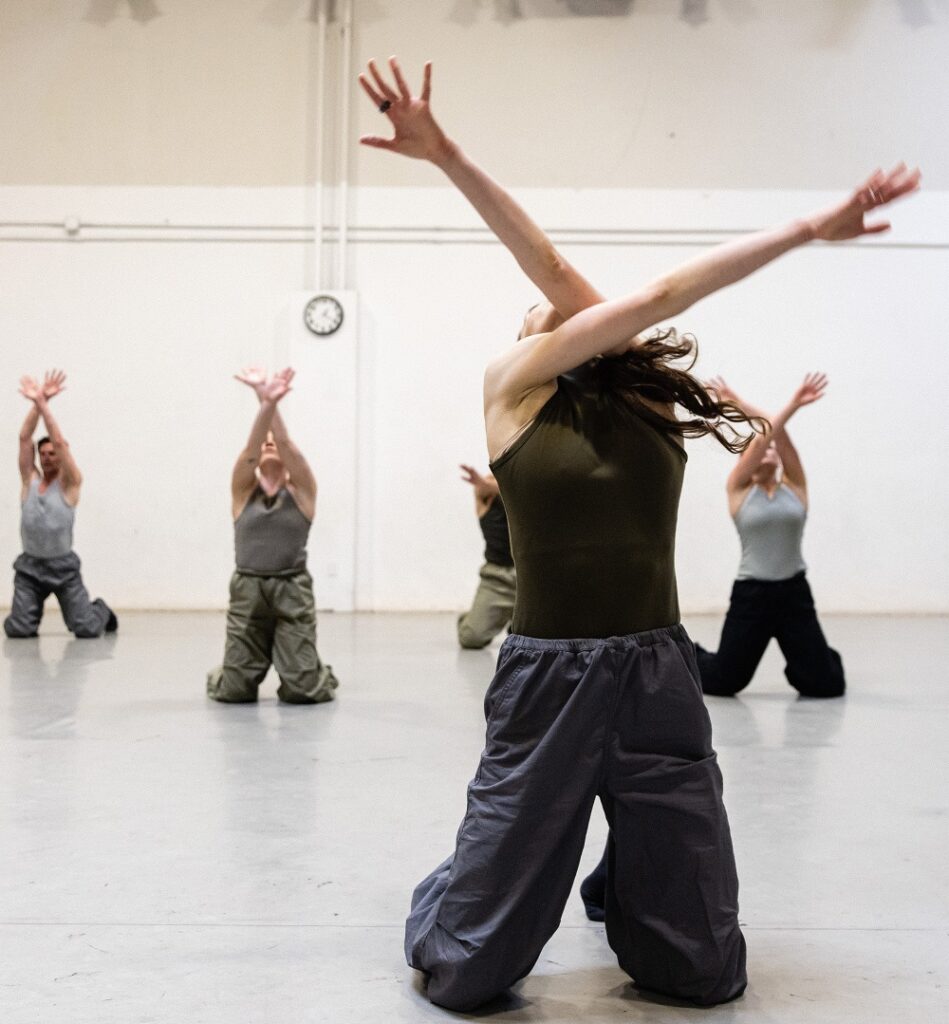
Laurie Sefton Creates – Nicholas Sipes, Maddie Lacambra, Marlie Couto, Sidney Scully in rehearsal of “Herd. Person?, Choreographer Laurie Sefton, dancers – Photo by Skye Schmidt Varga.
Also, the writing is such an interesting thing. I usually do a lot of writing before I start a piece, because my work is issue based. I do a lot of reading and a fair amount of research. I have ideas of what I want to do when I start, but by the time the piece is done, the piece hasn’t always let me do what I thought I wanted to do. The piece tells me something else, it takes its own path, and trying to squeeze it into the box of where I started doesn’t make for good work. So I would have to go back to what I wrote at the start and rewrite everything at the end.
LADC: Has your work always focused on different social and political issues?
Sefton: I started making work in high school, so I’ve been at it a long time. And at UCLA, I worked as an usher at a time when they were bringing in a lot of dance. When I was a member of the viewing committee for the now defunct Lester Horton Awards, I went to see everything, even if it wasn’t part of the viewing committee’s work. Even now I still see everything.
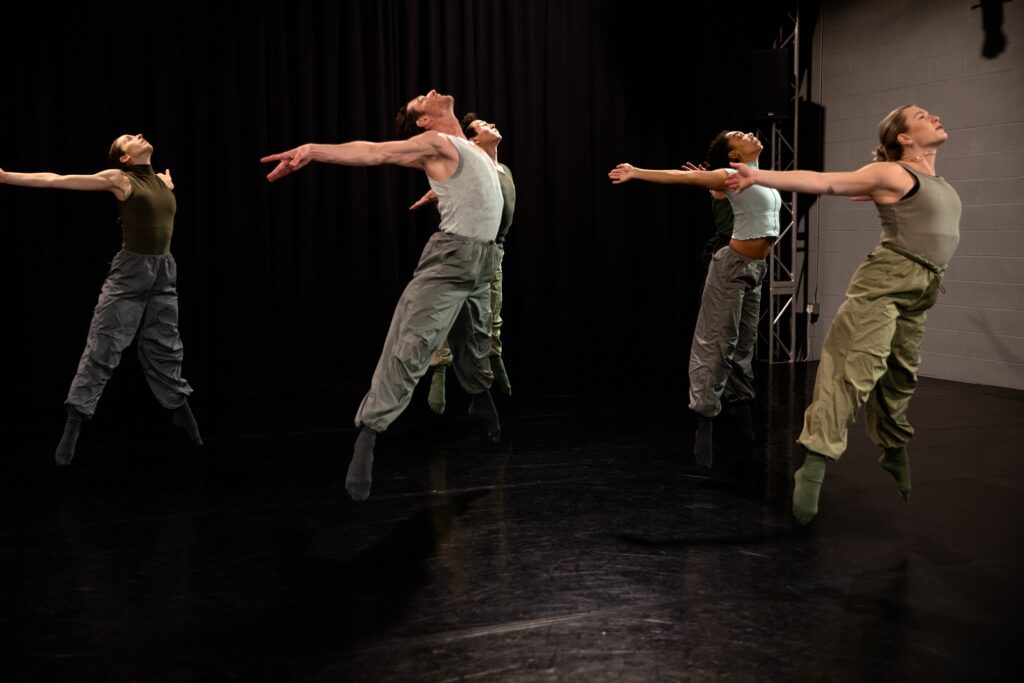
Laurie Sefton Creates – Marlie Couto, Nicholas Sipes, Isaac Huerta, Marirosa Crawford, Maddie Lacambra in rehearsal of “Herd. Person?, choreography by Laurie Sefton – Photo by Denise Leitner.
Somewhere along the way, I came to some conclusions. A lot people were making work about their own issues, using dance to work through emotional issues or trauma in their own lives. That definitely has value. Still, I thought any of those issues in my own life should have a deeper or larger issue beyond me. I made a decision to make work that had connection to a larger issue but still resonated somehow to my own life in some way. As a result, there isn’t anything I’ve made that I wouldn’t bring back today. I think it is important as dancemakers to bring access points for the audience and not just dance audiences.
LADC: How does that thinking fit with your new work?
Sefton: The piece deals with the idea of the individual versus the group. I sent the press release to someone who sent back an article about how as people we are hard-wired to be part of a tribe and how we select our “tribe.” I know I’m expressing an opinion in some ways but hopefully not divisive or preachy. I think it’s more important to say something people can have a conversation about no matter where they are coming from.
Group think is not necessarily “your think.” It’s important to consider how to still keep your singular identity when among the group. In a world where things are presented as “them” and “us,” it’s critical to find ways to remember that “either/or” is not necessarily true or the only way to think about things.
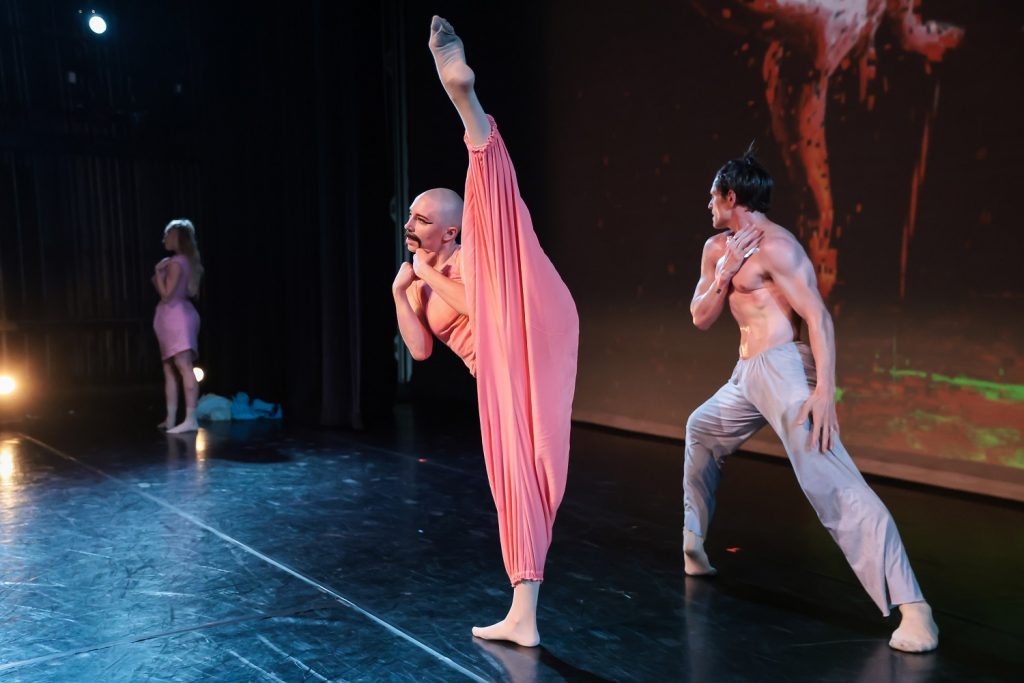
“The Mythology of Self” – Dancers Amanda de Oliveira, Gretchen Ackerman, Nicholas Sipes, Choreography by Laurie Sefton – Artwork by Paige Twyman – Photo by Skye Schmidt.
LADC: And the title Herd. Person?
Sefton: What is a herd? It’s a group that acts together, in some relationship. The topic is not necessarily about being a follower. The question mark is asking how you remain an individual in the moments you follow the herd. Hopefully, people will see ways that reflects the politics we’re inundated with social media and the 24-hour news cycle.
Actually, my last several works are tying together. Mythology of Self was about how we are invested in social media and altering the story about who we are as individuals Social media can guide you down a rabbit hole that isn’t where you started, but more extremist than where you started.
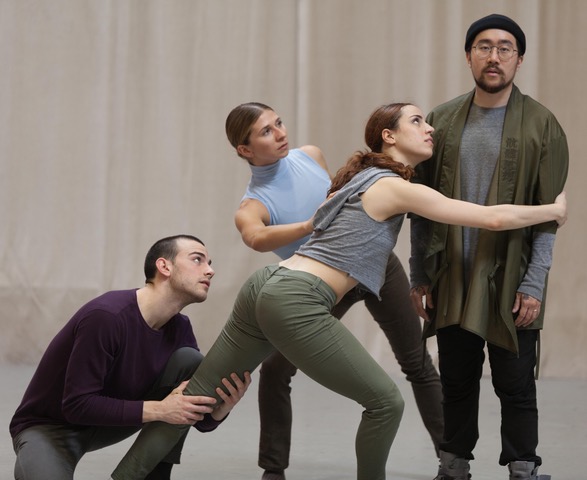
Rehearsal photo of “Triptych: Experience in Defiance” – Jonathan Stanley, Samantha Blaz, Camila Arana, Jason Chu – Photo by Denise Leitner.
LADC: And the other two works on the program?
Sefton: Triptych: Experience in Defiance was a collaboration with Jason (Chu) who performed onstage with the dancers. The work is a solo, duet, then a trio. It is much more stripped down than my more recent works, not as gestural. It’s a good step into my work. A lot of movement happens and then the words come, Jason’s thoughts on freedom, immigration and humanity’s struggle to stay engaged, so it connects with the audience in a different sort of way. Jason isn’t available for these shows, so the dancers will be viewed with his voice on tape.
The middle work, an excerpt from Girl Get Off considers the societal shift expanding gender and sexual orientation identifiers. Love is love and the freedom to experience joy and mutually consensual pleasure is a birthright independent of gender identification. When people who know my work see it for the first time, they are surprised that it came from me, but it’s 100 per cent from me. It’s just a different vocabulary.
LADC: This show you have eight dancers, some returning and some new dancers. How is it working with this larger group of dancers and working with dancers after three years of pandemic?
Sefton: It’s been an interesting experience this time. I’ve had a cast of seven or eight dancers before, but then it was a very different cast of characters.
Dance artists are different now than they were three, five, even two years ago Their personal goals are different; their needs and wishes and wants are different; their attitudes in rehearsal are different; their work ethic is different. I wouldn’t say any of that is bad, just different.
It’s a different generation of dancers coming up. I have dancers in my cast who are in their early to mid-20s and dancers in my cast who are over 30. Which did not seem like that big a gap when we started but there’s definitely a gap in their wishes, wants, abilities, and desires. And because I’m much older than them I feel it’s important to adapt to who I have dancing and what is happening in contemporary dance, so I can say ‘this is something I can incorporate into my work’.
LADC: What would you want audiences to know?
Sefton: Come with an open mind and try to absorb all of the aspects, try to observe, see, hear, and feel, not just see and hear. There is emotional content throughout all my work and hopefully, access points for everyone. That is something that I really strive towards. I know there have been times in dance when accessible is a dirty word. That somehow if things are too accessible, then it isn’t high art. I disagree with that 100 per cent. More and more I want to make work accessible for a global audience, because the physical communicates. We all have bodies, and dance connects in a way that theater or music alone doesn’t. Even if everything isn’t completely understandable, I hope there is something in my work that everyone can connect to, enjoy, and perhaps, think about.
Laurie Sefton Creates – Herd. Person? at LA Dance Project, 2245 E. Washington Blvd., Arts District; Thurs.-Fri., Feb. 22-24, 8 pm, $30. Events — Laurie Sefton Creates
To reserve your seat for Laurie Sefton Creates’ Herd. Person? at L.A. Dance Project, please click HERE.
For more information about L.A. Dance Project, please visit their website.
Compiled and Edited by Ann Haskins for LA Dance Chronicle.
Featured image: Laurie Sefton Creates – Rehearsal of Herd. Person? – Dancers: Sidney Scully, Myko Lyric, Nicholas Sipes – Photo by Skye Schmidt Varga.

